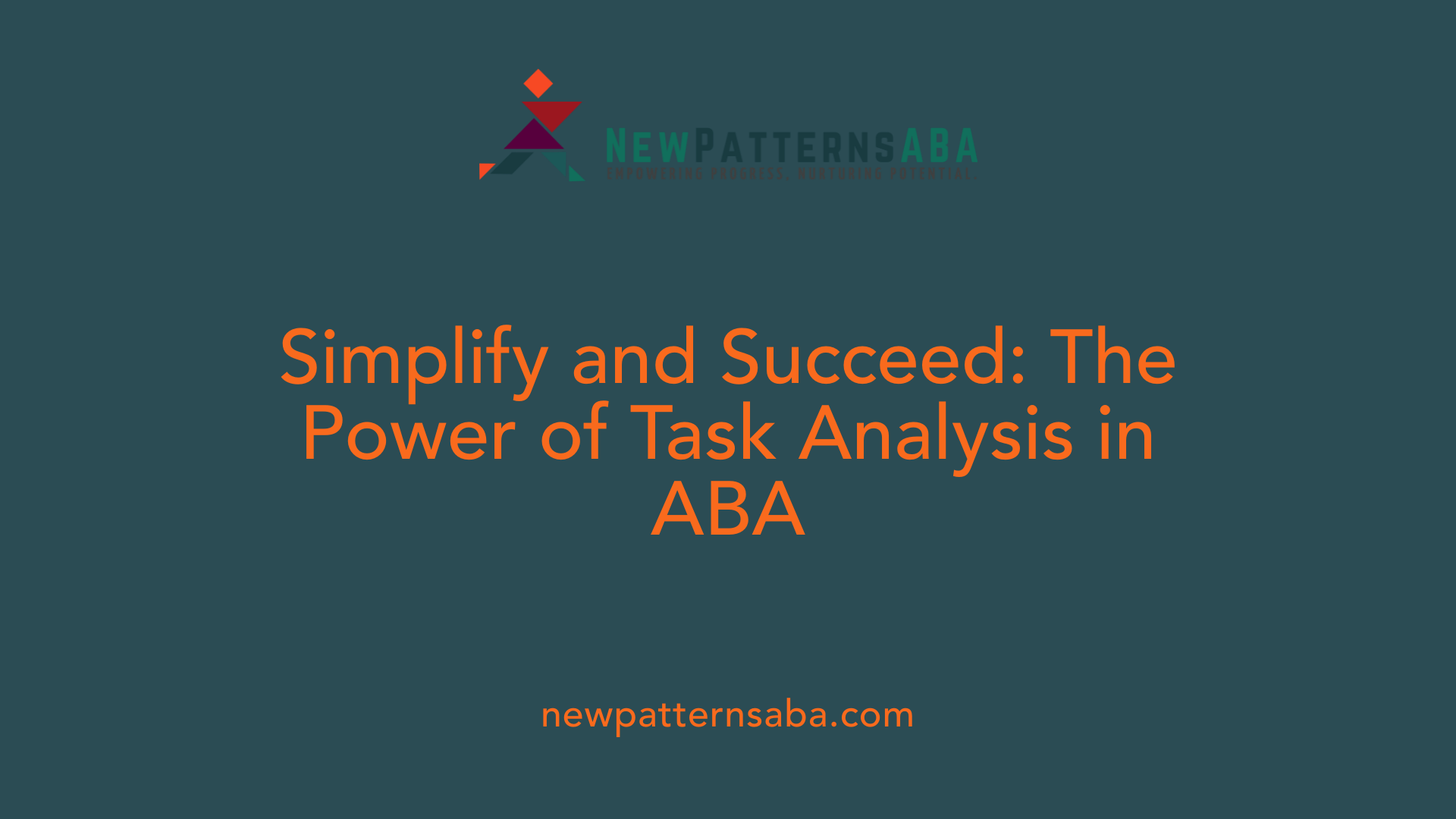Understanding the Impact of ABA Therapy on Instructional Skills
Children who struggle to follow multi-step instructions often face challenges in academic, social, and daily routines. Applied Behavior Analysis (ABA) therapy offers targeted strategies to support and improve these essential skills, fostering independence and confidence. This article explores how ABA therapy aids children in mastering multi-step instructions, enhances related social and communication skills, and prepares them for school success.
Breaking Down Complex Tasks for Better Comprehension

What is task analysis in ABA therapy?
Task analysis is a foundational technique in ABA (Applied Behavior Analysis) therapy. It involves breaking down complex activities into smaller, manageable steps to facilitate learning and independence. Each step represents a simple part of a larger task, making it easier for children to understand and complete activities successfully.
How does breaking tasks into smaller steps help children?
Children, especially those with developmental challenges, often struggle with multi-step instructions. Breaking these tasks into smaller parts reduces cognitive load and prevents overwhelm. It promotes clearer understanding of what needs to be done,
fosters confidence, and encourages mastery of each component before moving to the next. This approach supports gradual skill acquisition, boosts independence, and improves overall task completion.
Examples of step-by-step instruction breakdown
| Task | Breakdown Steps | Additional Support |
|---|---|---|
| Brushing Teeth | 1. Get toothbrush, 2. Apply toothpaste, 3. Brush teeth, 4. Rinse mouth, 5. Put toothbrush away | Use visual checklists, prompts, or modeling for each step |
| Dressing | 1. Choose clothes, 2. Put on shirt, 3. Button or zip, 4. Put on pants, 5. Tie shoes | Use visual routines, physical guidance, or verbal cues |
| Setting the Table | 1. Get plate, 2. Get fork and knife, 3. Place items on table, 4. Sit down | Use visual supports or demonstration to reinforce each step |
These examples illustrate how breaking activities into smaller steps can improve understanding and execution.
How does ABA therapy support children with difficulty following multi-step instructions?
ABA therapy supports children in following multi-step instructions by utilizing task analysis to break down complex activities into manageable, step-by-step components. Techniques such as forward and backward chaining help teach each step systematically, often supplemented with visual supports like schedules or cue cards to enhance understanding. Reinforcement, modeling, and prompting are used to encourage correct responses and build independence in completing multi-step tasks. Teaching simple, clear one-step directions initially establishes foundational skills, which are gradually expanded to encompass more complex, multi-step instructions. Overall, these structured approaches promote improved comprehension, task completion, and functional living skills.
Strategies and Techniques that Boost Instructional Understanding
What techniques and strategies does ABA therapy use to improve understanding of multi-step instructions?
ABA therapy employs several effective methods to help children understand and follow multi-step instructions. One of the primary techniques is task analysis, which involves breaking down complex commands into smaller, manageable parts. This ensures children can learn each step individually before combining them.
Prompting is also widely used. This might include visual cues, physical prompts, or verbal hints to guide the child through the task. Over time, prompts are gradually faded, encouraging the child to perform tasks independently.
Reinforcement plays a crucial role. Correct responses are rewarded with preferred items or praise, motivating children to follow through with the instructions.
To supplement these methods, visual supports like pictures, written cues, or charts provide clear, accessible reminders of the sequence, making it easier for children to grasp the entire process.
Modeling is another essential strategy. Therapists demonstrate the desired behavior or sequence, giving children a visual example to imitate.
Other systematic approaches include errorless learning, where prompts are used to prevent mistakes during initial learning phases, and structured curricula tailored to each child's needs. Regular data collection ensures that progress is monitored and strategies are adjusted accordingly.
Incorporating these techniques ensures that children with speech and language difficulties can better process and execute multi-step instructions, which are vital for academic success and daily living skills.
Key Benefits of ABA in Developing Core Skills

How does ABA therapy improve social skills related to following instructions?
ABA therapy provides substantial support in helping children develop essential social skills connected to understanding and executing instructions. It focuses on enhancing their ability to read social cues, like facial expressions and body language, which are vital for effective communication and interaction.
Through tailored strategies such as discrete trial training and natural environment teaching, children learn to grasp verbal and non-verbal cues more accurately. These approaches include role-playing and modeling behaviors that imitate real-life social situations, allowing children to practice and internalize appropriate responses.
ABA also supports language growth, expanding vocabulary and sentence formation, which are crucial for understanding multi-step instructions. For children with limited speech, alternative communication techniques, such as AAC devices, can be integrated to facilitate participation.
Social skills like turn-taking, sharing, listening, and engaging in conversations are reinforced through positive reinforcement, making these behaviors more likely to occur.
The overall goal of ABA in this area is to foster greater independence in following instructions and to improve social interactions. This ultimately leads to better participation in classroom activities and peer engagements, laying the foundation for successful social development.
How does ABA therapy enhance communication abilities?
ABA therapy employs evidence-based methods to boost various aspects of communication. It helps children develop functional language skills by expanding their vocabulary, sentence complexity, and ability to express needs effectively.
Using techniques like discrete trial training, therapists introduce new words and phrases in a structured way, ensuring mastery before moving on. Role-playing and modeling also provide practical context for applying these skills.
For non-verbal children, ABA integrates augmentative and alternative communication (AAC) tools to help them communicate more effectively. This reduction in frustration and increase in expressiveness enhances social participation.
In addition, ABA strategies improve receptive language—the ability to understand instructions and questions—making children more responsive in conversations and classroom activities. These improvements promote active engagement and learning.
How does ABA therapy foster independence and self-help skills?
ABA therapy supports children in developing essential daily living skills that promote independence. Therapists break down complex tasks like dressing, feeding, toileting, and managing personal belongings into smaller, manageable steps.
Reinforcement techniques encourage children to practice these routines repeatedly, leading to increased confidence and self-sufficiency.
The therapy also emphasizes establishing consistent routines and using visual schedules to help children adapt to daily expectations at home and school. Self-monitoring and behavioral chaining further support skill acquisition.
By fostering independence, ABA not only benefits daily functioning but also reduces reliance on caregivers over time. These skills are vital for successful participation in school and community settings, enhancing overall quality of life.
| Aspect | Description | Additional Techniques |
|---|---|---|
| Improving social skills | Enhances understanding of social cues, turn-taking, sharing, and listening | Role-playing, modeling, reinforcement |
| Enhancing communication | Builds vocabulary, sentence structure, and functional language | Discrete trial training, AAC devices, role-playing |
| Fostering independence | Teaches daily living skills like dressing, toileting, and routines | Task analysis, visual schedules, behavioral chaining |
| Overall benefits | Increased social participation, reduced problem behaviors, better self-help | Reinforcement, data collection, personalized plans |
This structured, personalized approach of ABA ensures children gain crucial skills that support their growth across social, behavioral, and communication domains, paving the way for a more independent and socially engaged future.
Preparing Children for School Transitions and Routines
How does ABA therapy assist with school readiness and transition for children who struggle with multi-step instructions?
ABA (Applied Behavior Analysis) therapy plays a significant role in helping children who have difficulty following multi-step instructions and managing transitions into school environments. It employs structured, evidence-based techniques to prepare children effectively.
One vital approach is the use of visual supports such as visual schedules, First-Then boards, and timers. These visual tools make daily routines more predictable, helping children understand what to expect at each stage. By providing clear visual cues, children learn to anticipate upcoming activities, which reduces anxiety and increases their confidence.
In addition, ABA incorporates social narratives and scripts tailored to specific situations, such as entering a new classroom or participating in group activities. These narratives prepare children emotionally and socially, helping them grasp social expectations and respond appropriately.
ABA strategies also focus on developing self-regulation and communication skills. Techniques like functional communication training empower children to express their needs and feelings during transitions, minimizing frustration or behavioral challenges.
Proactive steps—such as practicing routines at home, visiting new environments beforehand, and creating personalized visual supports—are essential. These preparations help children familiarize themselves with new settings and routines, easing the shift from familiar to unfamiliar environments.
Collaboration with therapists, teachers, and caregivers ensures that individualized plans are implemented. These plans combine visual supports, social narratives, and reinforcement strategies tailored to each child's needs.
Ultimately, ABA’s structured, systematic approach promotes independence, emotional stability, and social competence, making school transitions smoother and less stressful for children facing challenges with multi-step instructions.
Tools and Resources to Support Instructional Skills at Home and School

What resources and tools does ABA therapy provide to help children follow multi-step directions?
ABA therapy offers a range of effective resources and tools designed to help children improve their ability to follow multi-step instructions. Visual supports are fundamental; these include visual schedules, picture cue cards, and illustrated prompts that break down complex instructions into clear, manageable parts. These visual aids help children understand what is expected at each step, reducing confusion and increasing independence.
Prompts and cue cards are also frequently used by therapists and teachers. These cues serve as hints or reminders that guide children through each part of the task, gradually fading over time as children become more confident. Modeling correct responses is another key technique — demonstrating the desired behavior so children can imitate it.
Reinforcement systems are integrated to motivate children, rewarding successful completion of each step. This positive feedback encourages continued effort and skill mastery.
A crucial method in ABA therapy for teaching multi-step directions is task analysis. This involves breaking complicated tasks into smaller, sequential steps. The child then learns each step individually before combining them for the full task. This structured approach makes learning manageable and builds confidence.
Finally, technology-based teaching tools like apps and interactive devices complement these strategies, providing engaging ways for children to practice and master multi-step instructions. Combining visual supports, prompts, modeling, reinforcement, and technology helps children develop consistency and confidence, laying a strong foundation for independence in both educational and home settings.
Supporting Long-Term Development and Independence
Through the application of structured strategies like task analysis, prompting, visual supports, and reinforcement, ABA therapy significantly enhances children’s capacity to follow multi-step instructions. These skill improvements are fundamental to a child's academic success, social participation, and daily independence. Early and ongoing ABA interventions foster lifelong skills, reduce problematic behaviors, and prepare children for future challenges. Combining these targeted techniques with collaboration among therapists, educators, and families creates a comprehensive support system that empowers children to navigate complex instructions confidently, ultimately leading to greater independence and quality of life.
References
- What Is Kids Speech Therapy? A Complete Guide For Parents
- ABA School Readiness Therapy For Your Child - Step It Up ABA
- Understanding the Behavioral Aspect of ADHD and How ABA ...
- 50 Multi-Step Directions for Speech Therapy Practice
- Articles & Insights on ABA Therapy & Child Development
- How ABA Therapy Supports Child Development
- How ABA Therapy Can Improve Communication Skills in Children





